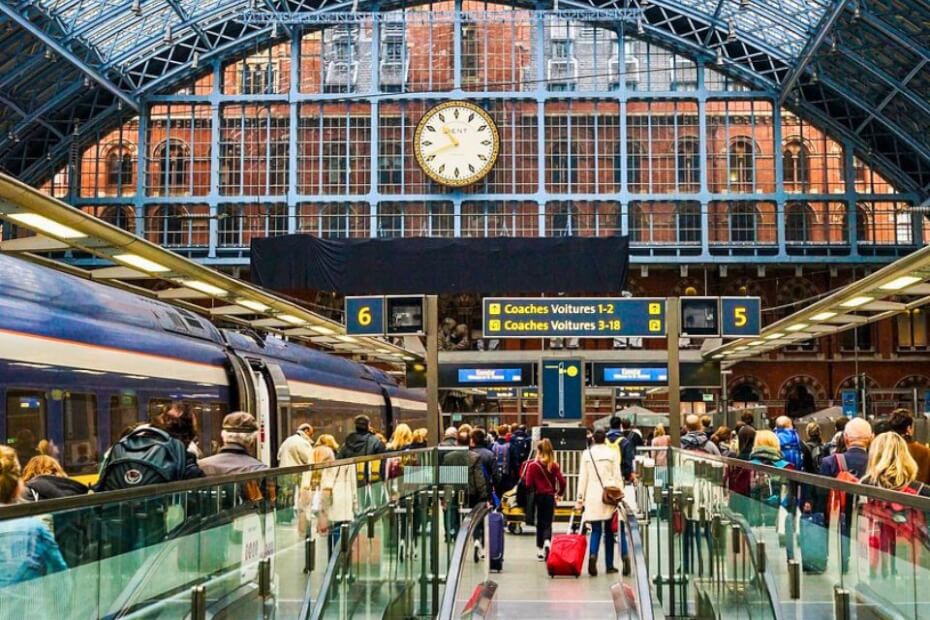
Eurostar is confident its passengers will not encounter massive delays once the European Union’s (EU’s) Entry/Exit System (EES) becomes operational.
Eurostar’s chief stations and security officer, Simon Lejeune, told a media briefing on 21 May that they have “the right setup” to enforce EES without delay.
“We are not going to ask our customers to arrive earlier,” he stressed, as per a report by The Standard.
Last week’s reports suggested that passengers may need to arrive earlier at St. Pancras station due to potentially long queues caused by the EES.
Lejune assured, “We are confident, and our modeling supports this, that, end to end, we are still going to be operating within the current check-in times.”
Lejune added that Eurostar is considering reducing the time passengers must check in before their trip.
This means passengers should arrive at the Eurostar area in St Pancras station 45 to 60 minutes before their train departs.
On the other hand, check-in time during peak hours is still 90 minutes before the train’s departure.
How the EES will work at Eurostar terminals
The EES records travelers’ entry and exit of the Schengen Zone using biometric data, such as facial and fingerprint scans.
It will replace manual stamping of passports at the border for non-EU nationals, such as short-stay visa holders and visa-exempt travelers. This includes British citizens.
The first time non-EU travelers enter the Schengen Zone, they must register their biometric data with the EES system before a border officer.
It will store their data for three years and refresh each time they cross the EU border within that timeframe.
If they visit the Schengen Zone after their biometric data has expired, they must register again before a border officer.
At St. Pancras Station, Eurostar is installing a total of 49 check-in kiosks and 11 electronic passport gates (eGates).
Additionally, 18 manual booths will be staffed by French border officers and located in three different areas of the station.
This is an increase from the current 24 kiosks, eight eGates, and no manual booths.
Eurostar states that the modifications will establish a seamless travel experience between the United Kingdom (UK) and the EU.
St. Pancras station will have a designated booth for passengers with mobility issues and premier class customers.
The station will also make space and open an overflow area during peak hours if needed.
Staff will also be available to assist passengers who may have difficulty with the new technology.
Passengers will also receive information on where to check in before they arrive at St. Pancras.
On the other hand, Paris Gare du Nord will open 18 new kiosks and 11 eGates.
In Brussels, the number of eGates will rise to 10, while manual gates will increase from four to eight.
Eurostar adapting to EES, more passengers
Eurostar chief executive Gwendoline Cazenave echoed Lejune’s comments that travelers won’t face long queues when the EES is active.
Both St. Pancras and Paris Gare du Nord are slated for redesign over the next five years to meet increasing passenger demand.
The redesign aims to expand the stations to accommodate 2,700 passengers per hour, up from the current 1,800 per hour.
Additionally, part of the planned St. Pancras redesign is to create more space for travelers to undergo EES biometric checks.
Eurostar’s terminal in Amsterdam will also expand. Once the expansion is complete, it will accommodate up to 600 passengers.
It currently serves only 200 passengers in its current capacity.
The cross-rail company is growing its operations following a first milestone: generating over €2 billion in revenue last year.
Passenger numbers also increased to nearly 19 million in 2023. The train operator anticipates an estimated 30 million passengers each year by 2030.
“There is huge demand for our services, and we have big European ambitions,” Cazenave told the Financial Times.
She added that Eurostar is “definitely” considering new routes from London to Europe.
Cazanave said the company is in talks with manufacturers to replace older trains and increase their fleet from 51 to 67.
Potential EES issues at St. Pancras Station
High Speed 1 (HS1) had previously warned that the EES preparations at St. Pancras station are “severely inadequate.”
The company running the London-to-Channel-Tunnel route said that limited space at St. Pancras makes it hard to enforce the EES.
The lack of space could lead to Eurostar limiting passenger numbers to avoid delays, HS1 warned.
Eurostar, then planning to have only 24 kiosks, stated that the EES would increase the processing time for border control by “two to three minutes.”
The potential delays would be even longer than the current processing time of 45 seconds and could lead to peak-time queues of over an hour.

